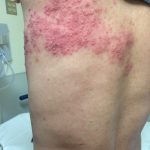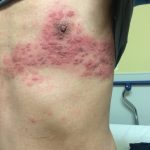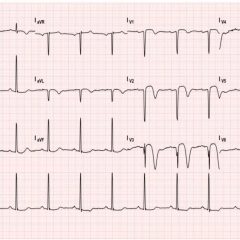Herpes Zoster
History of present illness:
A 26-year-old male presented to the emergency department with a burning rash over his left axilla and chest that started 2 days prior to presentation. The pain had been steadily worsening and was exacerbated by touch and the rubbing of his clothes over it. Patient denied fevers, chills, or weakness. Patient denied any past medical history, past surgical history or medications. He was unsure of his vaccination history and endorsed having chicken pox as a child.
Significant findings:
The patient was in mild distress, afebrile, with stable vital signs. His physical exam revealed an erythematous, grouped vesicular rash in various stages of progression including erythematous papules, clear vesicles, and pustular vesicles. Few lesions were scabbed over. No signs of crusting or scarring were appreciated. The distribution encompassed the entire left T4 dermatome both posteriorly and anteriorly. No other rashes were appreciated elsewhere on the body.
Discussion:
Herpes Zoster (HZ), also known as “shingles,” is a result of the reactivation Varicella Zoster Virus (VZV) that emerges from latency in the sensory dorsal root ganglion. The reactivation causes the spreading of a classic rash of group vesicular lesions in various stages along the unilateral sensory dermatomal distribution over the first 3 days. Ulceration and crusting begin to occur after 3-5 days.1 The diagnosis is usually made clinically; however PCR testing of skin lesions is also available to differentiate between VZV, HSV1, and HSV2.2 The incidence of HZ increases with age due to immunosenesacence of cell mediated immunity, with the mean age between 43 and 53 years old.3 An immunocompromised state, due to factors like human immunodeficiency virus (HIV), medications, and autoimmune disease, also increases the incidence of HZ.4-6 A routine HIV screening in this patient was negative. He was prescribed oral acyclovir 800 mg, five times per day for five days.
Topics:
Herpes, chicken pox, zoster, shingles, HSV, dermatology, rash.
References:
- Weinberg JM. Herpes zoster: epidemiology, natural history, and common complications. J Am Acad Dermatol. 2007;57(6 Suppl):S130-S135. doi: 10.1016/j.jaad.2007.08.046
- Schmutzhard J, Merete RH, Zweygberg Wirgart B, Grillner L. Detection of herpes simplex virus type 1, herpes simplex virus type 2 and varicella-zoster virus in skin lesions. Comparison of real-time PCR, nested PCR and virus isolation. J Clin Virol. 2004;29(2):120-126.
- Nagasako EM, Johnson RW, Griffin DR, Elpern DJ, Dworkin RH. Geographic and racial aspects of herpes zoster. J Med Virol. 2003;70 Suppl 1:S20-S23.
- Wung PK, Holbrook JT, Hoffman GS, Tibbs AK, Specks U, Min YI, et al. Herpes zoster in immunocompromised patients: incidence, timing, and risk factors. Am J Med. 2005;118(12):1416. doi: 10.1016/j.amjmed.2005.06.012
- Stankus SJ, Dlugopolski M, Packer D. Management of herpes zoster (shingles) and postherpetic neuralgia. Am Fam Physician. 2000;61(8):2437-2444,2447-2448.
- Chan SK, Lee KW, Hui CL, Chang WC, Lee EH, Chen EY. Gender effect on public stigma changes towards psychosis in the Hong Kong Chinese population: a comparison between population surveys of 2009 and 2014. Soc Psychiatry Psychiatr Epidemiol. 2017;52(3):259-267. doi:10.1007/s00127-016-1317-1
- Dworkin RH, Johnson RW, Breuer J, Gnann JW, Levin MJ, Backonja M, et al. Recommendations for the management of herpes zoster. Clin Infect Dis. 2007;44 Suppl 1: S1-S26. doi: 10.1086/510206




